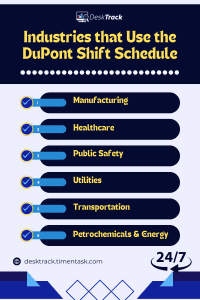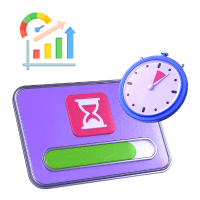
If your business runs non-stop, then you need the DuPont shift schedule. This alternative to the regular 5-day work week changes work hours to 12 hours, and the structure changes week after week in a 4-week cycle for each month. However, there is a lot more than you need to know about this strange yet effective schedule.
For starters, there are a lot of good parts for both the employers and employees in the monthly DuPont schedule, especially for the workers, such as more time off. However, there are cons as well, such as disturbed sleep cycles, which lead to the need for alternative employee scheduling. We will discuss that as well and more in today’s blog.
By the end of this post, you will have wrapped your head around all the ins and outs of the DuPont shift schedule. Plus, we will also reveal the best software solution we use that can effectively handle any type of scheduling. So, stick around till the last word, and let’s get started making 24/7 operations simple and effective for you.
What is the DuPont shift Schedule?
The DuPont work schedule is a fixed 4-week work loop where the staff works 12-hour days. It does look manageable on the surface. However, employees can work up to 72 hours weekly. This requires 4 teams, following their own monthly schedule, which covers 24 hours. Since 2 crews work all the time, it ensures continuous 24/7 operations with the program resetting at the end of every 4-week cycle. This breaks down into:
- 12-hour shifts (day and night)
- 4 teams cover alternating shifts
- A rotating 4-week schedule where each team works:
- 4 night shifts, 3 days off
- 3-day shifts, 1 day off
- 3 night shifts, 3 days off
- 4-day shifts, 7 days off
An Example DuPont Shift Schedule
For a clearer understanding, here’s a DuPont schedule example for you:
| Week | Monday | Tuesday | Wednesday | Thursday | Friday | Saturday | Sunday |
| 1 | Night | Night | Night | Night | Off | Off | Off |
| 2 | Day | Day | Day | Off | Night | Night | Night |
| 3 | Off | Off | Off | Day | Day | Day | Day |
| 4 | Off | Off | Off | Off | Off | Off | Off |
Read Also: The Critical Path Method in Project Management: Your Full CPM Guide
Common Modifications to the DuPont Shift Schedule
Make your workday more productive
Time tracking and work management can help you reach your goals
faster.
A good part about the DuPont shift schedule is that it’s flexible. According to your business and industry requirements, you may also make some modifications to ensure smooth workflows and employee well-being:
|
|
|
|
|
|
|
|
Industries that Use the DuPont Shift Schedule

Basically, in industries where it’s essential to operate 24/7, the DuPont schedule calendar is optimal. These sectors include:
- Manufacturing: Manufacturing units frequently run day and night to maintain production consistency. Thus, enterprises, such as automotive, chemical, and steel production, utilize the monthly DuPont schedule.
- Healthcare: Hospitals and healthcare facilities need 24/7 staff availability. This makes this rotating schedule a well-known option among nurses, doctors, and support staff.
- Public Safety: Police stations, fire departments, and emergency response services rely on it to ensure that their personnel can respond to emergency calls 24/7.
- Utilities: Power plants, water treatment facilities, and other utilities operate continuously to provide essential services to the public. The said schedule here ensures that skilled teams are always available to maintain and manage these critical infrastructure systems.
- Transportation: Airlines, railways, and transit organizations frequently use the DuPont shift schedule for air traffic controllers, train operators, and bus drivers.
- Petrochemicals & Energy: This sector is another DuPont schedule example, when it comes to usage. Oil refineries, chemical plants, and energy production units operate nonstop, making this schedule a valuable asset.
Is Overtime Possible in the DuPont Shift Schedule?
This has a higher chance due to operational demands needing extended hours or shifts:
- Laborers can average a maximum of 2 overtime hours in a 5-7 day work cycle.
- The schedule splits 168 hours into 4 teams, making each team work around 42 hours weekly.
- Due to the structure, employees have no choice but to work 6 12-hour shifts in just 7 days. Overall, for that week, we can observe 72 hours.
| Expert Tip |
| Overtime standards and calculations vary based on your business practices, industry policies, and legal regulations. |
Advantages of the DuPont Shift Schedule
Although employees must work 72 hours during one of the 4 weeks, there are many benefits of the DuPont shift schedule on the bright side:
- Reduces tiredness by rotating shifts. There are no stretches of overnight work.
- It ensures that at least 2 teams are on the clock. The structure removes the stress of making a schedule and makes it simple to facilitate time off requests.
- Although employees work longer 42-hour weeks, they enjoy 15 days off every 4 weeks.
- Planning family vacations, events, personal appointments, and other extracurricular activities is more manageable.
- Longer breaks between rotations allow for recovery from shift work.
- Provides a better work-life balance.
- Improves shift alertness.
- Leads to higher employee satisfaction and retention.
Disadvantages of the DuPont Shift Schedule
Like every other schedule out there, the DuPont shift program also has some major cons, especially when it comes to the mental health of the employees:
- It requires careful coordination for shift coverage.
- Workers require adjusting their sleep schedules when rotating.
- It can be tedious and not synchronize well with the lives of your family and friends. As a worker, organizing your personal life is challenging.
- There can be a negative impact on the mental health and sleep patterns of employees due to working longer shifts.
- It can be hard to get consistent 8 hours of sleep or have a healthy sleep cycle due to working 12-hour shifts. This can negatively impact general well-being and productivity.
- Potential for reduced continuity on projects between shifts.
- It can be complex to track payroll with multiple shift premiums.
- It doesn’t fully eliminate tiredness and safety issues associated with overnight shifts.
Alternatives to the DuPont Shift Schedule

There can be many reasons, such as not needing to operate 24/7, which may lead you to find a more feasible alternative to the DuPont schedule. Fortunately, you are in luck, as we have tons of other options for you:
- 2-2-3 Shift Schedule: This method implements a slow 28-day rotational loop, where every laborer tires out for 12-hour schedules day-wise.
- 4-10 Shift Schedule: This one provides you with 40 work hours in a 4-day workweek. Here, employees work 10-hour shifts and take Friday off.
- 9-80 Shift Schedule: Workers finish 80 hours of work in just 9 days, providing themselves with an extra day off. However, the time off happens only every other week.
- Flex Schedule: The contractors and laborers work together to fix the number of hours and days of work.
- Full Time: Employees work 8-10 hours daily, which equates to 40-50 hours per week.
- Part-Time: Part-time workers work and make less than full-time teams. However, there is more flexibility in the schedule. Nonetheless, some employers even offer part-time work over the weekends instead of the weekdays.
- Split Shift: This allows employees to break their day into multiple shifts. For example, a worker may work between 9:00 AM and 3:00 PM, go home, and then again clock in at 4:00 PM to work till 6:30 PM.
- Rotating Shift Schedule: This one cycles employees via day and night shifts.
- On-Call Schedule: There is no guaranteed time off. The compensation is also beyond work hours because the employees agree to work according to the employer’s demands.
- Compressed Work Schedules: This allows employees to reach their expected full-time hours in only 4 days.
- Irregular Shift Schedule: Laborers’ work hours and leaves change weekly. This likely changes based on enterprise requirements, seasonal workload, and employee obligations outside of work.
Is the DuPont Shift Schedule Right for Your Teams?

Whether this workforce management solution for scheduling is right for you and your teams depends on various factors. We already know one, which is the need to operate 24/7:
- Operational Requirements: First, you need to analyse the operational needs of your teams. If you expect 24/7 work coverage, then DuPont is right for you.
- Employee Preferences: As we already know, employee preferences are above all. Thus, conducting surveys and discussing with your teams will let you know if they are willing to comply.
- Legislative & Labor Union Considerations: You also need to ensure that your schedule and any modifications to it comply with the legislative and labor union laws and regulations.
- Training & Transition: At the end of the day, if you and your employees agree, it’s a good idea for you to train your employees and management for a smooth transition into the DuPont shift schedule.
Why is DeskTrack the Best Employee Scheduling Software?
Regardless of whether you are using the DuPont shift schedule or an alternative, you need the best employee scheduling software to effectively create, track, share, and manage shifts. With DeskTrack, you can make a schedule, no matter how complex it is, in 30 minutes. Plus, the user-friendly interface makes it easy to update the schedule in case of employee unavailability.
Furthermore, to monitor whether your employees are complying with the schedules, it also provides you with employee monitoring features such as real-time app, URL, and file usage monitoring. Overall, it’s the complete package for the monitoring and management of your field, remote, hybrid, and in-office employees and teams.
Frequently Asked Questions (FAQ)
Q. What is the DuPont Shift Schedule?
Ans. The DuPont work schedule is a fixed 4-week work loop where teams work 12-hour schedules. It does look manageable on the surface. However, employees can work up to 72 hours weekly. This requires 4 teams, following their own monthly schedule, which covers 24 hours. Since 2 crews work all the time, it ensures continuous 24/7 operations with the program resetting at the end of every 4-week cycle.
Q. Which Industries Use the DuPont Shift Schedule?
Ans. These industries require the said schedule:
- Manufacturing
- Healthcare
- Public Safety
- Utilities
- Transportation
- Petrochemicals & Energy
Q. What are the Advantages of the DuPont Shift Schedule?
Ans. Here’s why employees will agree to work DuPont:
- Reduces tiredness by rotating shifts. There are no stretches of overnight work.
- It ensures that at least 2 teams are on the clock. The structure removes the stress of making a schedule and makes it simple to facilitate time off requests.
- Although employees work longer 42-hour weeks, they enjoy 15 days off every 4 weeks.
- Planning family vacations, events, personal appointments, and other extracurricular activities is more manageable.
- Longer breaks between rotations allow for recovery from shift work.
- Provides a better work-life balance.
- Improves shift alertness.
- Leads to higher employee satisfaction and retention.
Q. What are the Cons of the DuPont Shift Schedule?
Ans. Consider these cons before implementing this schedule:
- It requires careful coordination for shift coverage.
- Workers require adjusting their sleep schedules when rotating.
- It can be tedious and not synchronize well with the lives of your family and friends. As a laborer, organizing your personal life is challenging.
- There can be a negative impact on the mental health and sleep patterns of employees due to working longer shifts.
- It can be hard to get consistent 8 hours of sleep or have a healthy sleep cycle due to working 12-hour shifts. This can negatively impact general well-being and productivity.
- Potential for reduced continuity on projects between shifts.
- It can be complex to track payroll with multiple shift premiums.
- It doesn’t fully eliminate tiredness and safety issues associated with overnight shifts.
Q. Are There Any Alternatives to the DuPont Shift Schedule?
Ans. If the said schedule is not fulfilling your requirements or if your employees disagree with its terms, then you have many other alternatives:
- 2-2-3 Shift Schedule
- 4-10 Shift Schedule
- 9-80 Shift Schedule
- Flex Schedule
- Full Time
- Part-Time
- Split Shift
- Rotating Shift Schedule
- On-Call Schedule
- Compressed Work Schedules
- Irregular Shift Schedule










